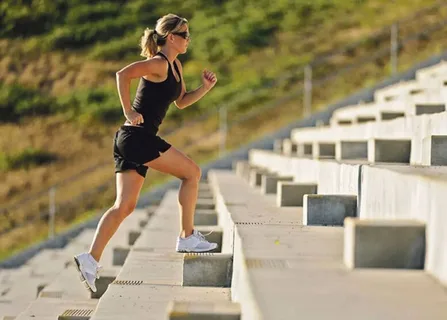Medically reviewed by Ana Maria Kausel, MD
“In order for man to succeed in life, God provided two means, education and physical activity. Lack of activity destroys the good condition of every human being, while movement and methodical physical exercise can save it and preserve it.” –Plato, 400 B.C.
Need a good reason to take the stairs? Here are six of them.

Stair Climbing Burns More Calories Than Jogging
Yes, it’s true: studies have shown that stair climbing, which is considered vigorous-intensity physical activity, burns more calories per minute than slower-paced jogging. One company, StepJockey, which is funded by the United Kingdom Department of Health and has as its sole mission the goal of getting everyone to take the stairs whenever and wherever possible, notes that stair climbing expends about 8 to 9 times more energy than sitting1 and about 7 times more energy than taking the elevator. As an added bonus, you burn calories not only on the way up but also while going down the stairs! It is estimated that the average individual will burn at least 0.1 calories for every step she climbs (so, at least 1 calorie for every 10 steps ascended) and 0.05 calories for every step descended (so, 1 calorie for every 20 steps on the way down). Perhaps even more encouraging to those who are already struggling with overweight or obesity: the more you weigh, the more calories you burn when stair climbing.
EXERCISES FOR OVERWEIGHT | OBESE PEOPLE. SET NO. 1: GENERAL EXERCISES TO STRENGTHEN MUSCLES AND IMPROVE JOINT MOBILITY
Stair Climbing Reduces the Risk of Stroke
According to results from the Harvard Alumni Health Study, which enrolled over 11,000 men, physical activity such as climbing stairs can reduce the risk of stroke. For instance, in men who reported climbing the equivalent of at least 20 flights per week, there was a recognizable reduction in their risk of stroke over the long term—and that was in addition to any benefits they may have had from other forms of regular exercise.2
EXERCISES FOR OVERWEIGHT/OBESE PEOPLE. SET NO. 3: POWER EXERCISES WITH DUMBBELLS. WEIGHT IS SELECTED INDIVIDUALLY. IT IS RECOMMENDED TO START WITH 1-2 KG
Stair Climbing Improves Cardiovascular Fitness
By virtue of being a form of vigorous exercise, stair climbing improves cardiovascular fitness—and, thus, cardiovascular health over the long term. Decades of research has shown that regular exercise improves cardiovascular fitness and can help prevent cardiovascular disease.3 Research also shows that regular physical exercise can increase healthy longevity by up to seven years!4
EXERCISES FOR OVERWEIGHT/OBESE PEOPLE. HYDROTHERAPY MODULE: SWIMMING AND HYDROTHERAPY, EXERCISES IN THE WATER
Stair Climbing Strengthens Muscles
Think about what it takes to climb the stairs. All the muscles in your legs, plus activating your abs, plus moving and perhaps pumping your arms—not to mention activating the muscles in your back. All of that translates into a stronger and healthier musculoskeletal system. And, since using skeletal muscle helps increase metabolism, that can translate into even more calories burned (and more weight lost) over the long run as lean muscle mass increases and muscle tone improves. Research has shown that using skeletal muscle also has a tremendous effect on improving blood sugar, which has implications for preventing and managing diabetes.5 Additionally, improving overall musculoskeletal health can help with arthritis pain, which tends to plague those who struggle with obesity as well.

Stair Climbing Is an Easy Way to Combat a Sedentary Lifestyle
A great deal of research points to the all-too-common sedentary lifestyle of today’s technologically advanced world as a major contributing factor to the global obesity epidemic. Taking the stairs whenever possible is a quick and easy way to break out of that sedentary lifestyle and add more physical activity and movement to your everyday life. The stairs are often right there in front of you, and so it can be a lot easier just to take the stairs than to get to the gym or get to the sports field.
and more…
You Don’t Have to Listen to Elevator Music
By Yasmine S. Ali, MD, MSCI
Yasmine Ali, MD, is board-certified in cardiology. She is an assistant clinical professor of medicine at Vanderbilt University School of Medicine and an award-winning physician writer.

DEMO VERSION OF GRS WORKOUTS FOR REHABILITATION OF PATIENTS with obesity ON YOUTUBE
Our website presents sets of exercises for the rehabilitation of the patients with obesity in the following areas:
-
EXERCISES FOR OVERWEIGHT/OBESE PEOPLE. SET NO. 1: GENERAL EXERCISES TO STRENGTHEN MUSCLES AND IMPROVE JOINT MOBILITY
-
EXERCISES FOR OVERWEIGHT/OBESE PEOPLE. SET NO. 2: POWER EXERCISES WITH A GYMNASTIC ELASTIC BAND/TERABAND
-
EXERCISES FOR OVERWEIGHT/OBESE PEOPLE. SET NO. 3: POWER EXERCISES WITH DUMBBELLS. WEIGHT IS SELECTED INDIVIDUALLY. IT IS RECOMMENDED TO START WITH 1-2 KG
-
EXERCISES FOR OVERWEIGHT/OBESE PEOPLE. HYDROTHERAPY MODULE: SWIMMING AND HYDROTHERAPY, EXERCISES IN THE WATER
Sources
https://www.verywellhealth.com/reasons-to-take-the-stairs-2509609
Verywell Health uses only high-quality sources, including peer-reviewed studies, to support the facts within our articles. Read our editorial process to learn more about how we fact-check and keep our content accurate, reliable, and trustworthy.
- Eves FF, Webb OJ, Mutrie N. A workplace intervention to promote stair climbing: greater effects in the overweight. Obesity (Silver Spring). 2006;14(12):2210-6. doi:10.1038/oby.2006.259
- Lee IM, Paffenbarger RS. Physical activity and stroke incidence: the Harvard Alumni Health Study. Stroke. 1998;29(10):2049-54. doi:10.1161/01.STR.29.10.2049
- Tian D, Meng J. Exercise for prevention and relief of cardiovascular disease: prognoses, mechanisms, and approaches. Oxid Med Cell Longev. 2019;2019:3756750. doi:10.1155/2019/3756750
- Reimers CD, Knapp G, Reimers AK. Does physical activity increase life expectancy? A review of the literature. J Aging Res. 2012;2012:243958. doi:10.1155/2012/243958
- Pesta DH, Goncalves RLS, Madiraju AK, Strasser B, Sparks LM. Resistance training to improve type 2 diabetes: working toward a prescription for the future. Nutr Metab (Lond). 2017;14:24. doi:10.1186/s12986-017-0173-7







